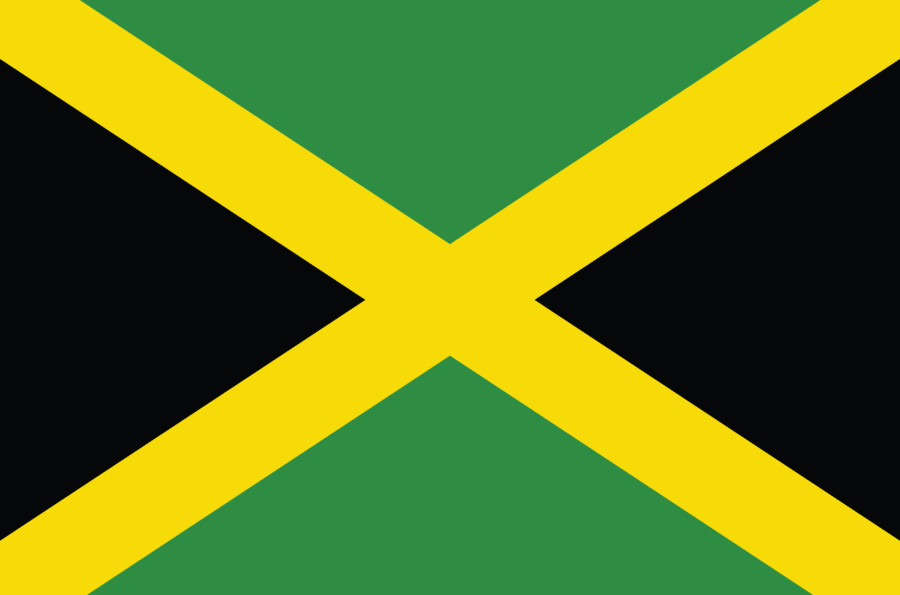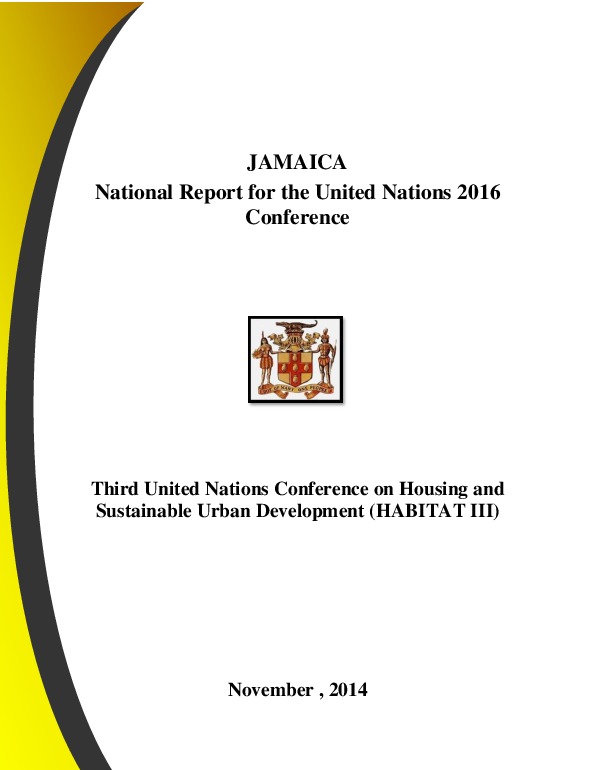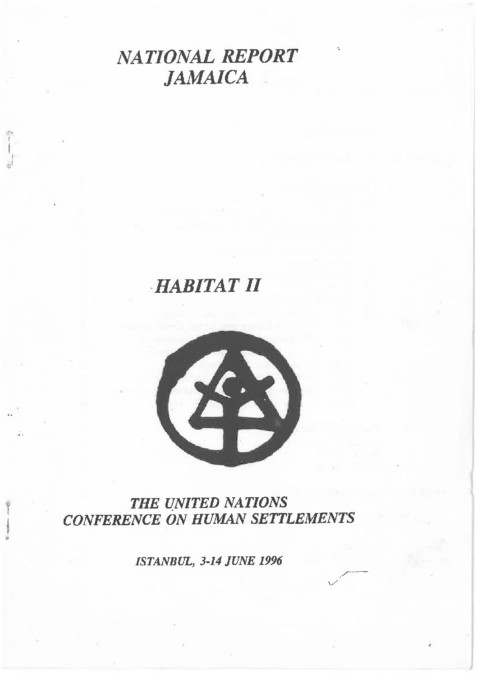
Jamaica
Urban indicators:
| Value | Year | ||
| Surface area (sq km) | 10991 | 2014 | |
| Population (proj., 000) | 2803 | 2016 | |
| Pop. density (per sq km) | 258.9 | 2016 | |
| Capital city | Kingston | 2015 | |
| Capital city pop. (000) | 588 | 2015 | |
| Population growth rate (average annual %) | 0.4 | 2010-2015 | |
| Urban population growth rate (average annual %) | 0.9 | 2010-2015 | |
| CO2 emission estimates (000 tons/tons per capita) | 7726/2.8 | 2013 | |
| Population using improved drinking water sources (urban/rural, %) | 97.5/89.4 | 2015 | |
| Population using improved sanitation facilities (urban/rural, %) | 79.9/84.1 | 2015 |
| 1995 | 2005 | 2014/2015 | |
| Urban population ('000) | 1,246 | 1,416 | 1,541 |
| Level of urbanization (%) | 50.6 | 52.8 | 54.8 |
| Proportion of urban population living in slum areas (%) | ... | 60.5 | 60.5 |
| Urban Slum Population ('000) | ... | 840 | 924 |
National Report:
National Report Executive Summary:
This report is undertaken in accordance with the Terms of Reference (TOR) for the preparation of National Reports on Housing and Sustainable Urban Development (Habitat III). Following on Habitat II, the United Nations General Assembly decided to convene the Third United Nations Conference on Housing and Sustainable Development, Habitat III, in 2016. Habitat III will be one of the first global conferences after the Post 2015 Development Agenda and is intended to provide the opportunity to discuss and chart new pathways in response to the challenges of urbanization and the opportunities it offers for the implementation of the sustainable development goals.
Member countries, for the purpose of this report, are being asked to describe what Central Government, Local Authorities, and other sub-national governmental authorities, in partnership with stakeholders, have achieved through the Habitat Agenda. The challenges experienced and lessons learnt, as well as future challenges and issues that could be addressed through a New Urban Agenda will also be discussed. The key elements that will be considered for creating a pattern of sustainable urban growth are:
- National Urban Policy: This establishes a connection between the dynamics of urbanization and the overall process of national development.
- Laws, institutions and systems of governance: These create the normative basis for action, the operational principles, organizational structures and institutional and societal relationships underlying the process of urbanization.
- Urban Economy: While there is a strong positive correlation between economic growth and urbanization, this potential relationship is not spontaneous and self-generating. Habitat III could be the means to put in place the central pillars for robust urban economic development.
As part of the preparations for Habitat III, the Government of Jamaica (GOJ) through the Ministry of Transport, Works and Housing (MTWH) established a National Habitat Committee. Information was submitted by committee members and other key stakeholders to inform the preparation of the report. Three regional consultations were conducted in Montego Bay (May 12, 2014), Mandeville (May 14, 2014) and Kingston (May 16th 2014) to solicit feedback from the private and public sectors as well as members of the public. This information was verified through desk studies and reviews by the Habitat Committee members and officers from the MTWH.
Urban Indicators Compilation: a number of ministries, departments, agencies, civil society groups and non-governmental organization (listed in the appendix) were conversant with each of the module areas and provided the required information.
A major achievement since the UN Habitat 1996 Report is the National Development Plan, Vision 2030 Jamaica, which sets out a strategic vision for the country and several sector plans (including Population, Urban and Regional Planning, Climate Change and Agriculture) to guide policy development and implementation, including systematic monitoring and evaluation. The Vision 2030 Jamaica promotes Jamaica as “the place of choice to live, work, raise families and do business”. Consistent with UN Habitat’s Agenda, Vision 2030 Jamaica is promoting “Sustainable Urban and Rural Development” by creating sustainable urban centres, through urban renewal and upgrading; and ensuring safe, sanitary and affordable shelter for all (National Outcome #15).
As part of the GOJ’s long-term housing and sustainable development planning several initiatives have been undertaken including:
- A draft National Housing Policy and Implementation Plan to provide an overarching framework to guide the housing sector is being finalised.
- A National Squatter Management Policy and Implementation Plan (NSMP) to address the issue of informal settlements.
- The Review of the National Transport Policy
- The development of the Jamaica National Environmental Action Plan (JaNEAP) 2006 –2009 is the Government of Jamaica’s 3-Year strategic action plan to address environmental and physical planning issues and represents a comprehensive update of the Actions outlined in the previous JaNEAP 1999 – 2002 and is consistent with new policy priorities of the Government. The Actions developed in the JaNEAP are intended to support the National Sustainable Development Strategy.
- The completion of the National Environmental Education Action Plan for Sustainable Development 1998-2010
- The formation of the Sustainable Development Council of Jamaica (SDC-J) under the United Nations Development Programme (UNDP) Regional Capacity 21 project, as an advisory body to promote discussion on sustainable development.
Population characteristic/urban characteristics:
Jamaica with a population of 2,697,983 and an area of 10,991 sq. kilometres is the third largest island and the largest English-speaking country in the Caribbean. With an annual estimated population growth rate of below 1 per cent since the 1990s (Table 1), it is expected that the island’s population will increase to 2,761,000 in 2015; 2,872,000 in 2030 and to begin declining by 2050. The vision statement guiding the population sector commits the country to “a population which meets the sustainable development needs of the country”. Data from the 2011 Population Census shows that 54 per cent of the population of Jamaica live in urban areas representing an intercensal increase of 1.9 per cent. It is projected that the urban population will increase to 58.0 per cent by 2030.
The country is currently at an intermediate stage in its demographic transition. This is reflected in a shift in the population structure marked by a declining child population (0-14) and an increasing working population (15-64) and dependent elderly age group (65+). The trend indicates both a decline in crude birth and death rates. The former brought about by a reduction in the island’s total fertility rate through extensive family planning campaigns and efforts to increase the contraceptive prevalence rates, the latter, is a consequence of improvements in the provision and access to medical services. The life expectancy is 78.02 for women and 70.40 years for males, the overall average life expectancy for Jamaicans is 74.15.
The county’s main economic activity is centred on service industries which accounted for 79.4% of GDP in 2013. The goods producing industry including: manufacturing, construction, mining, and agriculture, accounts for 24.6% of GDP. Remittances contributed 4% of GDP. The Jamaican economy currently faces serious challenges: a sizable trade deficit of approximately US$4 billion; high unemployment (15.2%); a debt-to-GDP ratio of almost 130%; and debt servicing accounting for about 44% of the fiscal budget.
In spite of the economic and security challenges, the country has been able to advance reaching 85th on the United Nations Human Development Index for 2012 where the development status is shared with Brazil. The International Monetary Fund (IMF) approved a four year Extended Fund Facility with the GOJ with the main objective to create the conditions necessary for sustained growth through significant improvement in fiscal operations, debt and competitiveness.
Statistics:
Urban housing indicators
People living in slums (%)
Urban population with access to adequate housing (%)
Basic services and infrastructure
Urban population with access to safe drinking water (%)
Urban population with access to adequate sanitation (%)
Urban population with access to regular waste collection (%)
Urban population with access to clean domestic energy (%)
Statements by Jamaica:
-
Intersessionals: Informal Intergovernmental Meetings (May 2016)
Statements by other countries on behalf of Alliance of Small Island States (AOSIS) and G77 and China:
-
Habitat III Plenaries
-
Intersessionals: Informal Intergovernmental Meetings (May 2016)
- Statement - 18 May (by Thailand) - English Made by Thailand on Behalf of G77 and China
- Statement - 18 May (by Maldives) - English Made by Maldives on Behalf of Alliance of Small Island States (AOSIS)
- Statement - 19 May (by Maldives) - English Made by Maldives on Behalf of Alliance of Small Island States (AOSIS)
- Statement - 19 May (by Kenya) - English Made by Kenya on Behalf of G77 and China
- Statement - 20 May (by Maldives) - English Made by Maldives on Behalf of Alliance of Small Island States (AOSIS)
- Statement - 20 May (by Thailand) - English Made by Thailand on Behalf of G77 and China
Events:
- At the Habitat III Conference:



